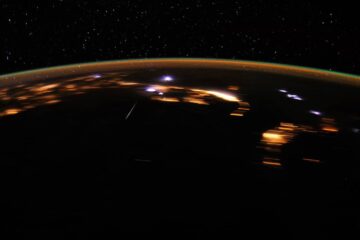Hello Stargazers! We are well and truly into spring now (and hopefully we have all recovered from losing that 1 precious hour of sleep when the clocks sprung forward, eh?). The high pressure weather system we have had recently means clear, crisp nights for many of us – excellent conditions for stargazing. If you have been considering stargazing as a hobby now is a great time to get into it as April has quite a few exciting stellar and planetary events to look out for.
As always, it’s ideal if you live outside a major city due to the light pollutions nowadays. However, even if you do live in one of the more light polluted areas on our island you’ll still be able to see a lot of interesting sights, so do give it a go! Remember to give your eyes around 20 minutes to fully adapt to the dark sky – you will see far more if you take these few minutes to adjust your vision.
The Super Moon
The April full moon is known as The Pink Moon.

Now, before I get your hopes up, the moon sadly won’t be pink. It will very much keep its silvery appearance in the night sky. The name “Pink Moon” comes from Native American tribes. They tended to name the months after the colours associated with time of year. The April full moon became The Pink Moon due to the appearance of Creeping Phlox and other pink foliage.
The full moon in April (on the 7th) will be the closest the moon will get to our planet all year! This is why it is dubbed a Super Moon – at a mere 221,772 miles away from us the moon will appear the largest it will be all year. It can appear 14% larger than the smallest full moon and up to 30% brighter!

While the moon is so big and so close, why not seize the opportunity to learn the different mare on the moon? Mare are the darker patches on the moon; mare (pronouced mah-rey) translates from latin to “seas” as early astronomers mistook these basaltic planes for actual seas of water. They are in fact areas of iron-rich moon rock formed by volcanic eruptions early in the history of the solar system. The iron makes them less reflective of the sun’s light and therefore they appear much darker to us on Earth. The mare all have different names – see if you can spot them all!

Early to rise? Spot some planets!
If you are awake early (around 5am – eek!) on the 15th of April, you will be greeted by a spectacular set of planetary companions. Face southeast and you will see Mars, Saturn and Jupiter in a line just above our moon. A triple planet spot – well worth getting up for!

Venus kisses The Seven Sisters
This evening (3rd April 2020) you will witness a once every 8 years event – our bright neighbour Venus will have an encounter with the Pleiades, better known as the 7 Sisters.

This young, bright star cluster lies within the constellation of Taurus. It has around 100,00 hot, young stars in its cluster but from earth we can only usually see around 6 or 7, hence the name 7 Sisters. The Pleiades, many years ago, were once an even greater spectacle – your grandparents would have been able to see up to 14 bright stars in this cluster alone! Don’t worry, the stars haven’t actually disappeared in decades since – one of the downsides of our technological advancements is the light pollution that accompanies it. To see what we once could you would need to travel to a Dark Site.

On the 3rd April in the evening, face southwest and you won’t be able to miss Venus shining brightly in the sky. Beside it, slightly to the right you will then spot the 7 Sisters. The brightest star beside Venus within this cluster will be Merope. Don’t miss out on this rare event!
The Lyrid Meteor Shower
At the end of April we will be treated to a meteor shower! On the nights of the 21st and 22nd of April (if you live in an area of low light pollution) you will be able to spot this meteor shower in the east of the sky, near the constellation of Lyra. You will have to contend with a brightish moon but as long as you aren’t in a city you should be able to catch a glimpse of this celestial light show.


Well Stargazers, I hope you enjoy the night time delights that April has to offer. Make sure you wrap up if you are trying to observe these delights as it’s certainly not warm yes! Oh, and due to our interesting times, remember to stay safe and stay home.



0 Comments